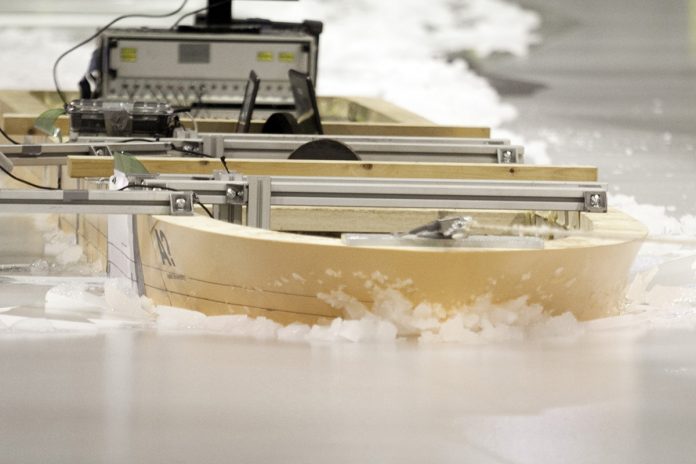Pentti Kujala from Aalto University provides a fascinating glimpse into the institution’s work on improving the safety of vessels present in harsh sea ice environments
The research group on Arctic marine technology and safety at Aalto University School of Engineering works towards improving the safety of vessels navigating in harsh sea ice environments, combining expertise in mechanical engineering, naval architecture, safety engineering and risk management. The multidisciplinary approach aims to create new knowledge about the interactions of sea ice with vessels in ship design and operational contexts. This is applied in practical applications or supports marine policy.
The group owns the Aalto Ice Tank, which is a 40m × 40m water basin equipped to produce sea ice in model scale. The facility is unique because of its dimensions and its large width. During 2014-2016, the Aalto Ice Tank has been totally renovated and upgraded with funding from the Academy of Finland Infrastructure Call and from the Ministry of Education and Culture. Finally, the research group is an active partner in various national and international research projects and collaboration networks, and actively engages with stakeholders to disseminate results and to facilitate their implementation.
Lloyd’s Register Foundation CEARCTIC
Research Centre of Excellence for Arctic Shipping and Operations (http://cearctic.aalto.fi/en/)
The scope of the Lloyd’s Register Foundation Centre of Excellence is the holistic treatment of design relevant features and their identification to advance safe arctic operations and transport. Holistic risk analysis typically includes a definition of hazard scenarios, their occurrence probability and consequences. For arctic operations, the definition of all these three elements is challenging due to data scarcity, the complexity of the sea ice environment and the stochastic nature of the ship-ice interaction. This holistic treatment is achieved through developing appropriate design frameworks, ensuring a consistent link between the different elements in the scenarios, while analysing their implications for the conceptual phase of ship design.
This holistic risk-based design approach advances the state of the art by explicitly identifying the scenarios, occurrence probabilities and consequences, making use of state of the art and newly developed first principle methods. Another key aspect of this novel design approach is its focus on the design relevant actions occurring during the entire life-cycle of the ship or installation, and not only on the initial service load conditions. This is followed by a selection of required safety features based on standard regulations.
SEDNA
Safe maritime operations under extreme conditions; the Arctic case
Maritime traffic in the Arctic region is rapidly increasing, posing safety risks to human activities in the Arctic, while raising concerns about environmental pollution. Safely operating vessels in Arctic environments is a prerequisite for sustainable transportation and economic growth. The SEDNA project aims at developing an innovative and integrated risk-based approach to safe Arctic navigation, ship design and operation, to enable European maritime interests to embrace the Arctic’s significant and growing shipping opportunities while safeguarding its natural environment.
The project creates and demonstrates improved safety outcomes through focusing on two aspects: the safe Arctic ship and safe Arctic navigation. Aalto University participates in the development of a risk-based design framework to ensure that vessel design is connected to all key hazards of ship operation in the Arctic.
BONUS STORMWINDS
Strategic and operational risk management for wintertime maritime transportation system
Maritime transportation is of vital importance to the countries surrounding the Baltic Sea area. During winter, ship navigation is challenging due to the presence of sea ice, especially in the Northern Baltic Sea area. Accidents occur more frequently than in open water conditions and although the consequences typically are minor, serious accidents involving oil spills could occur, potentially leading to significant environmental and economic damages. BONUS STORMWINDS addresses these risks on several accounts.
A first research theme concerns risk-informed planning and decision making for maintaining necessary response capabilities for possible accidental pollution. Knowledge is generated about navigational accidents in ice, about the future sea ice climate in the Northern Baltic Sea and about oil spill recovery effectiveness in ice. Improved oil outflow models from damaged tankers in ice conditions are developed, and the state of art SeaTrack Web tool is improved to better account for oil drift in ice conditions.
A second research theme is the development of approaches for enhanced situational awareness and operational planning for ship navigation in Baltic Sea ice conditions. A method is developed for classifying satellite images in terms of expected ship performance and method is developed to support operational route planning in the sea ice environment, accounting for ship performance and safety.
A third research theme focuses on developing an integrated tool for enhancing situational awareness in oil pollution response operations. The tool facilitates planning and response, aiming to minimise the harm to maritime ecosystems in the case of an accidental oil spill. The Next-Generation SmartResponse Web tool integrates a module for predicting oil outflow from a damaged vessel with the operational SeaTrack Web platform to predict the oil drift, linking this also to the environmental sensitivity of the marine areas.
Please note: this is commercial profile
Pentti Kujala
Professor
Aalto University
Tel: +358 400 878145











